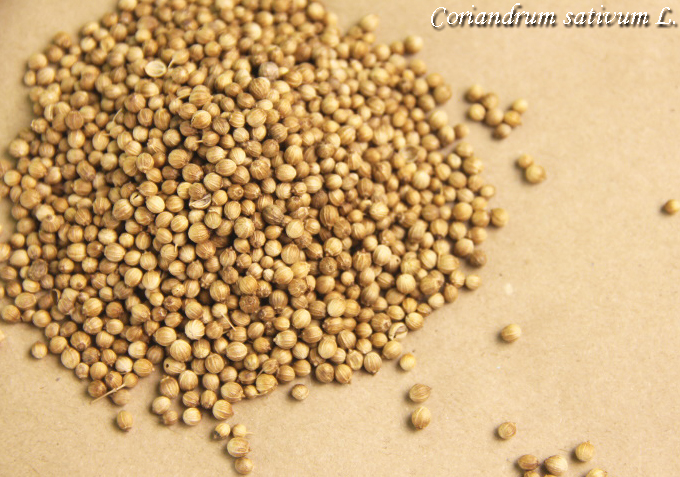Ex Tax: 5.05€
1 gramm = 70-100 seeds.
Very aromatic green sprouts with a refreshing taste for year round cultivation.
Good for the cardiovascular system and the digestive tract.
Coriander sprouts are an excellent seasoning for fresh and stewed vegetables, baked fish and grilled meats.
Coriander seeds, like coriander sprouts, have unlimited culinary uses.
Especially appreciated in Latin American and Asian cuisines.
Nutritional value of cilantro microgreens:
* alpha-carotene, beta-carotene, C, A, E and K, as well as B vitamins (B1, B2, PP, B4, B5, B6 and B9)
* a source of iron, copper, manganese, potassium, magnesium, phosphorus, sodium and zinc
* contains dietary fiber, essential oils (giving the coriander sprouts a characteristic aroma).

1. Fill the germination container with the substrate: peat, earth or coconut fiber (you can use a special container for germination on water).
2. Spread the seeds from the bag evenly over the surface (do not deepen), sprinkle with a thin layer of substrate and compact.
3. Place the container with seeds in a warm, bright place.
4. Moisten crops as needed.
5. After 7-10 days (depending on the culture), in the phase of the first pair of true leaves (2-5 cm), microgreens are ready for harvesting and contain the maximum amount of nutrients.
6. Carefully cut the greens just above the roots with scissors. Juicy sprouts are ready to eat. Remove the roots.
7. Reuse the container with the substrate to germinate the next batch of seeds.
8. Microgreens can be stored in the refrigerator for up to 5 days by placing them in a container or plastic bag.
.jpg)
Heirloom Coriander (Chinese parsley, cilantro), Non-hybrid, Untreated, Non GMO, vegetable garden on the windowsill: especially interesting and useful seeds for germination.
Potential problems.
In general, the short life of microgreens does not give them time to get sick, but in some cases, failures are still possible. The appearance of mold is the main problem that can occur when growing microgreens. This happens when low-quality seeds infected with parasites or diseases are used for sowing. Therefore, if you doubt the quality of your seeds or use self-collected material, it is better to pre-soak them in a solution of soda (1 g per 200 ml) or boric acid (0.2 g per 1 l) for a day.
To successfully grow microgreens, mold must be fought. It is important to ensure the cleanliness of the germination equipment, washing all containers after each harvest and disinfecting them from time to time. The soil can be used several times, but before the next sowing, it must be calcined or spilled with a solution of potassium permanganate. Mold can appear when sowing too densely in several layers, as this disrupts the ventilation of the sprouts.
Excessive lighting promotes the growth of pathogenic fungi, which is good for mold, but is not required for awakening plants. To avoid these problems, you should carefully monitor the process. Then you will have the opportunity to grow your own vitamin crop right in the kitchen.
So where does mold come from on microgreens?
This phenomenon is not uncommon, especially among beginners. But do not worry, because it is not so difficult to cope with this problem. However, the appearance of mold in itself indicates that something is wrong ...
There may be different reasons: high humidity, lack of lighting, lack of ventilation and much more. If you do not take action, you risk getting inedible microgreens or being left without a harvest at all. Depending on the type of fungus, mold colonies look different. The appearance of mold on microgreens is caused by microscopic fungi that have different colors and shapes, but the reasons for their appearance remain the same. If the soil is too wet, this can lead to the appearance of mold. In this regard, it is important to monitor the humidity level and not allow it to be excessive. To solve this problem, you can make holes in the trays in which the microgreens are grown to drain excess water. Also, stagnant water in the tray can cause root rot, since it interferes with air circulation. When you grow microgreens indoors without air movement, for example, in a greenhouse, insufficient lighting and poor ventilation can be a problem. Therefore, it is worth providing a ventilation system to avoid this problem. Sunlight can be destructive to mold, so it is necessary to provide sufficient light for the plants, but not overdo it to avoid harm to the microgreens. If you use soil as a substrate, it is easier and cheaper, but to avoid problems with mold, it is better to sterilize the soil beforehand. If you grow microgreens hydroponically, mold problems usually do not arise, since everything is easily controlled and sterilized.
To prevent contamination of the soil, it is better to sterilize it. To do this, you need to put wet soil in the oven, heat it up to +80 °C and let it cool.
To avoid problems with mold-infected seeds, it is recommended to add a teaspoon of 3% hydrogen peroxide to the water when soaking microgreen seeds. This should kill the mold.
Root hairs are an important component of plant growth, which can easily be confused with mold. Some novice microgardeners are afraid of their appearance, but in fact, this is not a problem. It is only necessary to avoid planting too densely, as this can lead to a lack of air circulation and the appearance of mold. The same problem can occur at the sprout stage. In addition, it is worth noting that mold, although undesirable, also has its own special beauty. There are several ways to get rid of mold. The most common method is to add 3% hydrogen peroxide or white vinegar to a spray bottle and spray the entire tray whenever mold is found. It is recommended to use a 750 ml sprayer, into which 25 ml of hydrogen peroxide and 25 ml of white vinegar are poured, and then topped up with water to the top. However, do not forget that too much solution can negatively affect the microgreens and cause them to "burn". If mold does appear, measures must be taken to eliminate it. If mold has massively affected the entire tray and green parts of your plants, it is better not to take risks and plant everything again, taking into account previous mistakes.
Cilantro microgreen has a specific, but pleasant peppery-lemon flavor with a slight pungency, being a valuable dietary product, recommended for the prevention and treatment of many diseases, as well as the general health of the body.
One of the rare properties that this plant possesses is the ability to remove heavy metals such as lead, mercury and others from the body.
Sprouted coriander seeds also have a cooling effect and stimulate appetite.
They help with diabetes by regulating blood sugar levels, as well as lowering bad cholesterol and normalizing blood pressure.
Due to the high content of antioxidants, carotenoids (lutein and zeaxanthin) in seedlings, their consumption helps prevent age-related eye degeneration and related diseases such as cataracts and early glaucoma.
The content of vitamin K and calcium in coriander shoots helps to strengthen bone and connective tissues, teeth and hair.
In addition, it helps with inflammation of the oral cavity, bleeding gums, as it has an antiseptic and anti-inflammatory effect.
Germination.
Rinse the seeds thoroughly (conveniently with a sieve cover), add water (+ 40 + 50 °С) and put in a warm place for 8-12 hours. After soaking, drain the water, rinse the seeds again.
Next, plant the seeds in a tray on a pre-moistened coconut substrate or mat. Cover the tray with the same inverted tray on top, or wrap it in cling film and put it in a dark, warm place. If necessary, moisten the substrate with a spray bottle 1-2 times a day.
All these procedures should be done for 4-6 days or until the seeds germinate, then put the tray under the phytolight or on the windowsill, watering and growing microgreens up to 5-8 cm.
Germination features: coriander seeds dry quickly, after washing, add 10-15 ml of water.












